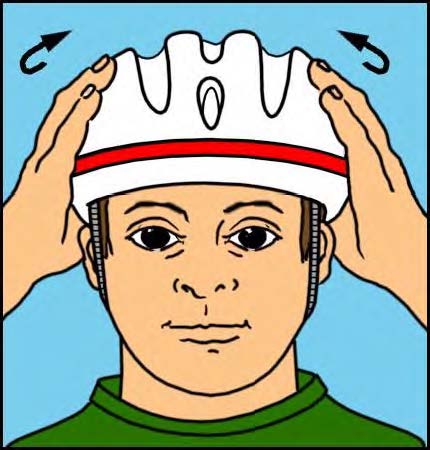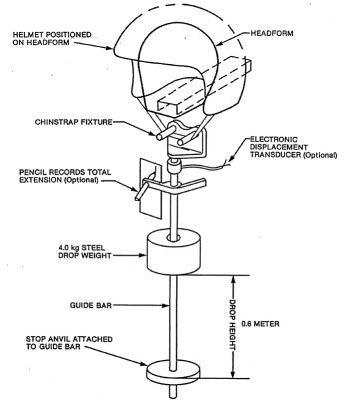Bicycle Helmets
This regulation sets performance requirements for helmets to protect bicycle riders from head injuries caused by falls or crashes. Bicycle helmets that fail any of the requirements violate the Consumer Product Safety Act.
The requirements are published in the Code of Federal Regulations (C.F.R) in Title 16, Part 1203.
A bicycle helmet is any headgear marketed as protecting a bicycle rider from head injury while riding, or that is marketed or promoted in a manner that implies it provides such protection. If a helmet is marketed or represented as providing protection during general use or in a variety of specific uses other than bicycling, it is still regarded as a bicycle helmet if a reasonable consumer could conclude, from the marketing or promotion, that bicycling is among the uses for which the helmet is intended. Footnote 1 to §1203.4(b) of the regulation lists the factors the Commission will consider in making a determination whether a multi-purpose helmet is a bicycle helmet.
Helmets specifically marketed for exclusive use in an activity such as skateboarding, in-line skating, baseball, or roller hockey are not covered by the requirements for bicycle helmets.
Helmets are tested to make sure that
- they do not block the riders vision (the "peripheral vision test"),
- they do not come off when the rider falls (the "positional stability test),
- the straps that hold a helmet on a rider’s head do not stretch enough to let the helmet come off in an accident (the “retention strength test”), and
- the helmet significantly reduces the force to the rider’s head when the helmet hits a hard surface (the “impact attenuation test”).
Each of these tests is summarized in detail below.
|
Yes. The chart below shows the different tests for each helmet. Please note the anvils listed in the impact test are the different surfaces on which the helmets must be dropped during the test. The anvils simulate surfaces like pavement or curbing that a rider who falls might hit. See §1203.17(a)(5) of the regulation for more detail about the sizes and shapes of the different anvils.

Test helmet samples 1- 4 in the schedule above for strength retention before you test the helmets for impact attenuation. Attach the helmet to a headform that does not have a chin portion, and fasten the headform to a fixture that holds it firmly. Fasten the helmet straps together, and hang the test fixture as shown in Figure (next page) from the straps. As you can see, part of the fixture is made of a steel rod at least 2 feet (0.6 m) long that runs through the middle of a circular sliding 8.8 pound (4 kg) weight and ends in a bottom anvil that will stop the weight when it drops. Mark the lowest position of the straps, using the marker system or transducer shown in Figure below, or some other method that will record how much the straps stretch during the test. Raise the weight 2 feet, drop it onto the lower anvil, and measure how much the straps stretched during the impact.
|
A helmet passes the test
- if the straps do not come apart or detach from the helmet during testing, and
- the straps do not stretch more than 1.2 inches (30 mm).
Because of the complexity of this test, we have not attempted to include all of the details and test procedures in this summary. The provisions of §1203.17 contain more specific information. Before and after each series of tests, perform an equipment systems check following the procedures in §1203.17. To test a helmet, place an instrument that measures peak acceleration in the headform to be used in the test, and attach the headform to a monorail or guide wire test apparatus. See Figure below. This apparatus guides the headform to the anvil when the headform is dropped during testing. Securely attach the helmet to the headform so the helmet will not shift position when it is dropped. Adjust the headform and anvil so that the area of the helmet that hits the anvil is the area most likely to reach the highest acceleration.
Following the schedule (previous page), drop each helmet on the appropriate anvil. A helmet dropped on the flat anvil has to hit the anvil at a specific velocity, about 20 ft/sec (6.2 m/sec), which typically means that the helmet must drop at least 6 ½ feet (2 m). A helmet dropped on the hemispherical or curbstone anvil has to hit at a velocity of about 16 ft/sec (4.8 m/sec), which typically means the helmet must drop almost 4 feet (1.2 m). Record the peak acceleration of each impact. Drop helmets 1 through 4 on the schedule above each a total of 4 times, twice on the flat anvil and twice on the hemispherical anvil, so that the helmets hit each time on or above the impact test line you drew on the helmet. Make sure that a different part of the helmet hits the anvil each time. This means that you must adjust the headform after each drop. The center of any part of the helmet that hits the anvil during a test must be at least 4.72 inches (120 mm) away from the center of any other point on the helmet that has already hit an anvil in an earlier test. Drop helmets 5 through 8 one time each on the curbstone anvil, so that each helmet hits on or above the impact test line. |
A helmet fails the test if any of the samples tested under any of the conditions described above shows a peak acceleration of more than 300 g.
Yes. A projection that extends more than 0.28 inches (7 mm) from the outside surface of a helmet must break away or collapse when you hit it with the same force that the helmet receives when you test it for impact attenuation. The inside surface of a helmet may not have any projection that extends more than 0.08 inches (2 mm) inside the helmet.
To make sure that a helmet does not block a rider’s side vision, a helmet must let the rider see without interference for at least 105° on either side of the center of his or her face. Please see §1203.14 for the test to determine whether a helmet meets this requirement.
Mount a headform designed with a full chin on a test fixture so that the face of the headform faces downward at 45°. Attach the helmet to the headform correctly and tighten the straps to remove any slack. Attach a cable or strap to the back of the helmet with a hook, and run the cable or strap over the middle of the top of the helmet. Attach the other end of the strap to a test fixture made of a steel rod at least 2 feet long (0.6 m) that runs through the middle of a circular sliding 8.8 pound (4 kg) weight and ends in a bottom anvil that will stop the weight when it drops. See Figure below for a diagram of the test apparatus.
Raise the weight 2 feet (0.6 m) and drop it so that it hits the anvil. After testing the headform face down, run the same test with the headform facing up. Please see §1203.15 for more detail about this test.

The helmet must not come off of the headform when the weight is dropped 2 feet (0.6 m) onto the bottom anvil.
- Every bicycle helmet must have instructions telling riders how to make sure the helmet fits properly and how to wear it properly. The instructions must include a picture showing the proper way to wear the helmet.
- Every bicycle helmet must be marked with the following information so that it is legible and clearly visible:
- The model number or designation.
- A warning that no helmet can protect against all possible impacts, and that death or serious injury could happen.
- A warning that, for maximum protection, the helmet must fit the rider’s head properly, and that the rider must properly put the helmet on and hook the straps together, following the manufacturer’s instructions. This warning must also be on the package of the helmet.
- A warning that a helmet that has received an impact may be damaged so much that it no longer protects the rider, and that such damage may not be visible. This warning should tell the user to return to the manufacturer any helmet that has received such an impact, or to destroy and replace it.
- A warning that common cleaners such as ammonia, bleach, etc. may damage the helmet and that such damage may not be visible. This warning should list the most common cleaners or other products that can damage the helmet, and warn against using those cleaners. It should also generally tell consumers how to clean the helmet and what cleaners to use, and should refer them to the instruction manual for more detail.
All of the warnings above must start with the word “Warning” in capital letters and bold type. See §1203.6 for more specific information on the labeling requirements.
- Each bicycle helmet must have a label certifying that the helmet meets the requirements of this standard. The label must include:
- a specific statement that the helmet complies with the standard;
- the name, address, and telephone number of the manufacturer or importer issuing the certificate, or of the private labeler of the helmet;
- the name and address of the foreign manufacturer, if the helmet was manufactured outside the U.S., and
- information, such as a serial number, that allows you to identify the production lot of the helmet, and the month and year the helmet was manufactured.
Please see §1203.34 for more information about where you should place these labeling statements on the helmet.
The certifications that manufacturers and importers issue must be based on a reasonable testing program of the helmets. Certification testing assures that all helmets produced for sale perform effectively. Rather than testing helmets themselves, importers may rely on tests performed by foreign manufacturers if the importer is a resident of the U.S. or has a resident agent in the U.S, the importer has examined the records of the tests to determine that the test records have all of the information required by §1203.41 of the regulation, and the importer can provide those records to the Commission within 48 hours of a request from the Commission staff.
Yes. Manufacturers and importers must keep records of all tests performed on helmets to determine whether they comply with the requirements. You must keep the record for at least 3 years after the date of certification of the last bicycle helmet in each production lot that has been tested. If you do not have a copy of the records to give to the Commission staff at the time you receive a request, you must be able to provide the records within 48 hours. Please see §1203.41 for more detail on what information you must include in the records.




